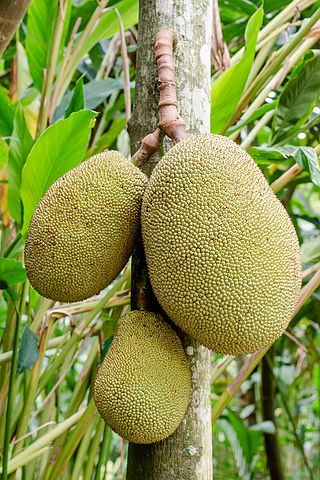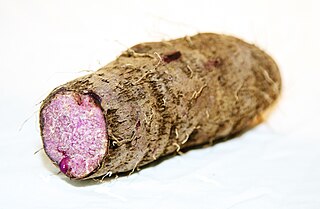Uses
As food
With
thoran prepared in Kerala style cuisine
Curry made using flower
In Indian state of West Bengal, Assam and in neighbouring country Bangladesh, it is called ol (ওল/ওল কচু). It is usually eaten as mashed or fried or added to curries and, more rarely, used in pickle or to make ol chips. [11] In some households, the green leaves and stems are also cooked as green vegetables. [12]
In Maharashtra, Uttar Pradesh and Gujarat, It is called suran.
In Bihar, it is used in oal curry (i.e. elephant foot curry), oal bharta or chokha, pickles, and chutney. [13] Oal chutney is also called barabar chutney as it has mango, ginger, and oal in equal quantities, hence the name barabar (meaning "in equal amount").
In Chhattisgarh, it is called zimmikanda or zaminkand and eaten as curry, being a delicacy among people of Chhattisgarh.
In Tripura, it is called batema and prepared by making a paste with sodium bicarbonate (baking soda) and water to remove its raphides (calcium oxalate needles). The paste is shaped into buns and boiled with water containing baking soda, after which the water is discarded. The buns are then cut into pieces and combined with fresh garlic paste and mosdeng (a spicy paste of dried fish/shrimp and chili). Also, the leaves and stems are eaten by chopping them into pieces and frying.
In Karnataka, it is called suvarnagadde.
In South India, especially Kerala, it is known as chena (ചേന), and the tuber has been a part of people's diet for centuries. In Tamil it is called kaaraa karanai kizangu (காறாக்கரணைக் கிழங்கு) or chénaikkizangu (சேனைக்கிழங்கு). It is mainly served as steamed pieces (പുഴുക്ക്) along with traditional chutney made of green chili, coconut oil, shallots and garlic, although the curry preparation is also common as a side dish for rice. It is made into a thick chutney (masiyal, மசியல்), typically eaten as an accompaniment with a rice dish. The tuber is popular among the Telugu-speaking states, too, where it is cooked along with the leaves of Indian spinach, tamarind pulp, and spices, to a vegan stew that is specifically served and consumed during devotional feasts and auspicious celebrations like housewarming and baby-showers. It is also cut into thin slices or strips and fried as a snack, much like potato fries. It has served as the main source of carbohydrates especially during the famine-stricken days of the region in the past along with the more popular tapioca for many centuries. The flower bud, before it blooms, is also used for making curry. All parts of the flower can be used for making different types of side dishes.
In Nepal, it is called oal, kaan, or suran, and is grown mainly in the southern plains of the country. Its curry is consumed in Jitiya and Deepawali festivals.
In the Philippines, it is known as pongapong. The young leaves, stems, and corms are consumed as vegetables or turned into desserts. They are thoroughly cooked to destroy the stinging oxalate crystals. [14]
As medicine
The elephant-foot yam is widely used in Indian medicine and is recommended as a remedy in all three of the major Indian medicinal systems: Ayurveda, Siddha and Unani. [15] The corm is prescribed in those systems for a variety of ailments. The tuber is reported to be useful in treatment of piles. [16]

The Araceae are a family of monocotyledonous flowering plants in which flowers are borne on a type of inflorescence called a spadix. The spadix is usually accompanied by, and sometimes partially enclosed in, a spathe. Also known as the arum family, members are often colloquially known as aroids. This family of 114 genera and about 3,750 known species is most diverse in the New World tropics, although also distributed in the Old World tropics and northern temperate regions.

Amorphophallus is a large genus of some 200 tropical and subtropical tuberous herbaceous plants from the Arum family (Araceae), native to Asia, Africa, Australia and various oceanic islands. A few species are edible as "famine foods" after careful preparation to remove irritating chemicals. The genus includes the Titan arum of Indonesia, which has the largest inflorescence of any plant in the genus, and is also known as the 'corpse flower' for the pungent odour it produces during its flowering period, which can take up to seven years of growth before it occurs.

Colocasia is a genus of flowering plants in the family Araceae, native to southeastern Asia and the Indian subcontinent. Some species are widely cultivated and naturalized in other tropical and subtropical regions.

Root vegetables are underground plant parts eaten by humans as food. In agricultural and culinary terminology, the term applies to true roots such as taproots and tuberous roots as well as non-roots such as bulbs, corms, rhizomes, and stem tubers.

The jackfruit is a species of tree in the fig, mulberry, and breadfruit family (Moraceae). The jackfruit is the largest tree fruit, reaching as much as 55 kg in weight, 90 cm in length, and 50 cm in diameter. A mature jackfruit tree produces some 200 fruits per year, with older trees bearing up to 500 fruits in a year. The jackfruit is a multiple fruit composed of hundreds to thousands of individual flowers, and the fleshy petals of the unripe fruit are eaten.

Dioscorea alata – also called ube, ubi, purple yam, or greater yam, among many other names – is a species of yam. The tubers are usually a vivid violet-purple to bright lavender in color, but some range in color from cream to plain white. It is sometimes confused with taro and the Okinawa sweet potato beniimo (紅芋), however D. alata is also grown in Okinawa. With its origins in the Asian tropics, D. alata has been known to humans since ancient times.

Konjac and konnyaku are common names of Amorphophallus konjac, a vegetable species native to Yunnan in southwest China which has an edible corm. It is also known as konjaku, konnyaku potato, devil's tongue, voodoo lily, snake palm, or elephant yam. It is a relative of the titan arum, one of the largest flowering plants in the world and a congener of konjac.

Trinidad and Tobago has a unique history and its food is influenced by Indian-South Asian, West African, Creole, European, American, Chinese, Amerindian, and Latin American culinary styles. Trinidadian and Tobagonian food is dominated by a wide selection of dishes, most notably, doubles, roti, pelau, callaloo and curried crab and dumplings. Trinidad and Tobago is also known for its prepared provisions, such as dasheen, sweet potato, eddoes, cassava, yam, soups and stews, also known as blue food across the country. Corresponding to the Blue Food Day event held annually in Trinidad and Tobago.

Sri Lankan cuisine is known for its particular combinations of herbs, spices, fish, vegetables, rices, and fruits. The cuisine is highly centered around many varieties of rice, as well as coconut which is a ubiquitous plant throughout the country. Seafood also plays a significant role in the cuisine, be it fresh fish or preserved fish. As a country that was a hub in the historic oceanic silk road, contact with foreign traders brought new food items and cultural influences in addition to the local traditions of the country's ethnic groups, all of which have helped shape Sri Lankan cuisine. Influences from Indian, Indonesian and Dutch cuisines are most evident with Sri Lankan cuisine sharing close ties to other neighbouring South and Southeast Asian cuisines.

Taro is a root vegetable. It is the most widely cultivated species of several plants in the family Araceae that are used as vegetables for their corms, leaves, stems and petioles. Taro corms are a food staple in African, Oceanic, East Asian, Southeast Asian and South Asian cultures. Taro is believed to be one of the earliest cultivated plants.

Assamese cuisine is the cuisine of the Indian state of Assam. It is a style of cooking that is a confluence of cooking habits of the hills that favour fermentation and drying as forms of preservation and those from the plains that provide extremely wide variety of fresh vegetables and greens, and an abundance of fish and meat. Both are centred on the main ingredient — rice. It is a mixture of different indigenous styles with considerable regional variations and some external influences. The traditional way of cooking and the cuisine of Assam is very similar to South-East Asian countries such as Thailand, Burma (Myanmar) and others. The cuisine is characterized by very little use of spices, little cooking over fire, and strong flavours due mainly to the use of endemic exotic fruits and vegetables that are either fresh, dried or fermented. Fish is widely used, and birds like duck, pigeon, squab, etc. are very popular, which are often paired with a main vegetable or ingredient; beef used to be eaten before British colonialism, and some continue to do so. Preparations are rarely elaborate. The practice of bhuna, the gentle frying of spices before the addition of the main ingredients so common in Indian cooking, is absent in the cuisine of Assam. The preferred oil for cooking is the pungent mustard oil.

Tamil cuisine is a culinary style of Tamil people originating in the southern Indian state of Tamil Nadu and neighboring Sri Lanka. Meats, along with rice, legumes, and lentils, are popular. Dairy products and tamarind are used to provide sour flavors. On special occasions, traditional Tamil dishes are served in a traditional manner, using banana leaves in place of utensils. After eating, the banana leaves are then used as a secondary food for cattle. A typical breakfast meal consists of idli or dosa with chutney. Lunch includes rice, sambar, curd, kuzhambu, and rasam.

Zoophily, or zoogamy, is a form of pollination whereby pollen is transferred by animals, usually by invertebrates but in some cases vertebrates, particularly birds and bats, but also by other animals. Zoophilous species frequently have evolved mechanisms to make themselves more appealing to the particular type of pollinator, e.g. brightly colored or scented flowers, nectar, and appealing shapes and patterns. These plant-animal relationships are often mutually beneficial because of the food source provided in exchange for pollination.

Carrion flowers, also known as corpse flowers or stinking flowers, are mimetic flowers that emit an odor that smells like rotting flesh. Apart from the scent, carrion flowers often display additional characteristics that contribute to the mimesis of a decaying corpse. These include their specific coloration, the presence of setae and orifice-like flower architecture. Carrion flowers attract mostly scavenging flies and beetles as pollinators. Some species may trap the insects temporarily to ensure the gathering and transfer of pollen.

Yam is the common name for some plant species in the genus Dioscorea that form edible tubers.
Bhojpuri cuisine is a style of food preparation common among the Bhojpuri people of Bihar, Jharkhand and eastern Uttar Pradesh in India, and also the Terai region of Nepal. Bhojpuri foods are mostly mild and tend to be less hot in terms of spices used. The cuisine consists of both vegetable and meat dishes.

Amorphophallus titanum, the titan arum, is a flowering plant in the family Araceae. It has the largest unbranched inflorescence in the world. The inflorescence of the talipot palm, Corypha umbraculifera, is larger, but it is branched rather than unbranched. A. titanum is endemic to rainforests on the Indonesian island of Sumatra.

Vada, vadai, wada, bara, or bora is a category of savoury fried snacks native to India. Vadas can be described variously as fritters, cutlets, or dumplings. Vadas are sometimes stuffed with vegetables and traditionally served with chutneys and sambar.

Medu vada is a South Indian breakfast snack made from Vigna mungo. It is usually made in a doughnut shape, with a crispy exterior and soft interior. A popular food item in South Indian cuisine it is generally eaten as a breakfast or a snack.

Eulophia obtusa, a showy and distinctive species of orchid, popularly known as the ground orchid, recorded from Bangladesh, North India and Nepal. This orchid growing in seasonally in grassland. It is a grass associated orchid species. A Bangladesh based renowned botanist and ornithologist Md Sharif Hossain Sourav first described this rare species from Bangladesh in 2017. There are only three collections in the Kew Herbarium dates from 1902, which suggests that it is quite a rare species. It is assessed as critically endangered (CR) in Bangladesh according to the IUCN Red Listing criteria. Very recently this species was rediscovered in India after 118 years.


























